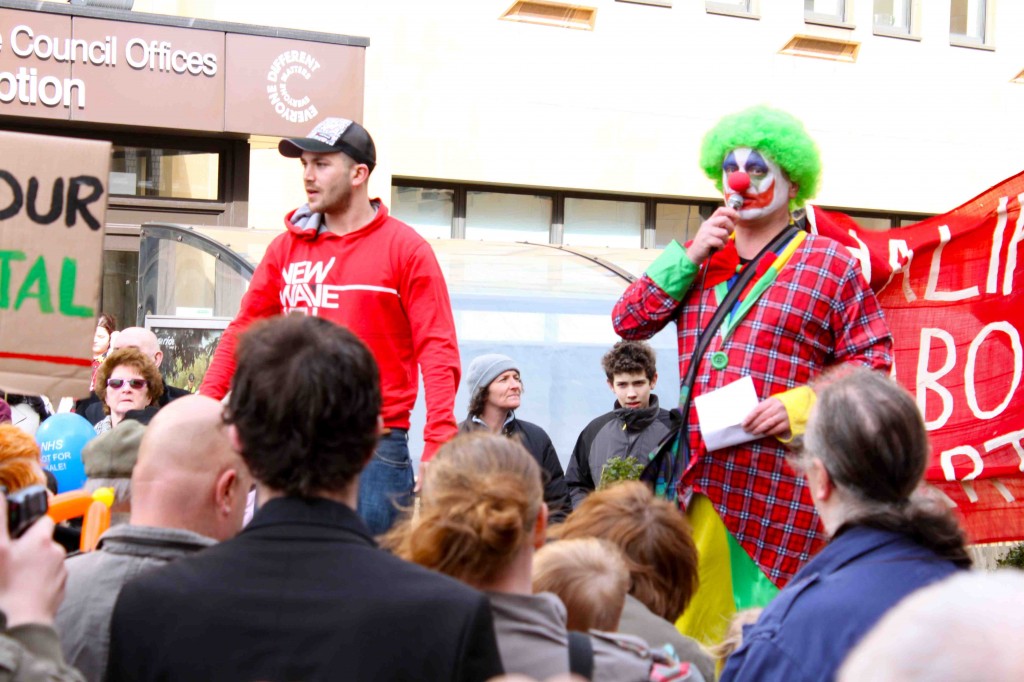Calderdale and Huddersfield hospital Trust’s Outline Business Case (OBC) is supposed to incorporate changes suggested by public, patients and stakeholders, during the Trust’s “engagement” process on the Strategic Outline Case.
But the OBC airbrushes the public’s and Calderdale Council’s rejection of their earlier Strategic Outline Case (SOC).
The Trust has been selective about what it includes from “engagement” with the public and patients.
The OBC ignores the evidence from sustained public protests and from Calderdale Council’s rejection of the SOC, that its proposals don’t have the support of the public or key stakeholders.
The Strategic Outline Case was greeted by widespread public protests, which led Calderdale Council to tell the Trust that the SOC proposals were unfit for the Calderdale public, and ask the Trust to withdraw them.
There is likewise no mention in the OBC of public scepticism about the value of the Trust’s public engagement events.
And despite the fact that the OBC foresees a net loss of 409 Whole Time Equivalent (WTE) hospital jobs, it claims (p83) that its proposals
“correlate to the views and issues that have been raised by service users and members of the public. Local people have told us they want more staff in hospitals…Changes to hospital services will give more effective delivery of workforce capacity. This will enable 7 day working and the increased presence of senior doctors for extended hours.”
A Plain Speaker report has already looked at the Outline Business Case proposals for cuts to acute and emergency hospital services, moving health services into the “community”, and the reorganisation of Calderdale Royal Hospital into a small planned care clinic while all acute and emergency services go to Huddersfield.
This Plain Speaker report looks at the OBC’s information on the Trust’s finances and jobs.
Jobs
As already mentioned, the OBC says that the proposed cuts to acute and emergency hospital services will mean 409 WTE hospital jobs will go over the next ten years (p133)
This includes the loss of 100 support services jobs as a result of contracting-out support services eg laundry, and 68 non-clinical ward support jobs eg cleaning, catering, porters etc.
It sees a cut of 224 ward based nurses and health care assistants as a result of hospital bed cuts, but an increase of 106 staff to “enable 7 day working and improved nurse staff ratios” for the “residual bed base”. The 409 job cuts are net – they take account of the 106 additional nurses for 7 day working and improved nurse staff ratios.
On p 134, the OBC says the increase in community health services will mean an additional 175 WTE community health staff over the next 3 years.
The OBC says that the Trust hopes to be able to retrain staff so that if their hospital jobs are cut, they can be redeployed to work in community health services instead.
The workforce model in the OBC doesn’t include the impact of increased out of hospital sevices on GP practices and social care.
The OBC notes that national shortages of key elements of the workforce is one of the drivers of the proposed NHS shake up.
This was also clear in the 2013 NCAT Report, that recommended the hospital services cuts and changes that the SOC and now the OBC both propose.
Capital funding options – more PFI a possibility
Alarmingly, given the Calderdale Royal Hospital (CRH) PFI burden – which takes around 10% of Calderdale’s annual NHS budget to repay the PFI debt and the costly PFI service charges for running things like housekeeping and maintenance – the OBC considers the possibility that at least some funding for the building work needed to run the rejigged hospital services could come from PF2 – the new PFI scheme that critics say is just as bad as the first wave of PFI schemes.
The OBC says that PF2 is “the government’s preferred procurement strategy for involving private finance in the delivery of public infrastructure and services” and the the OBC’s estates and services requirement are suitable for PF2.
The OBC says that the Trust needs £345m capital funding to carry out the necessary building work for option 2 – which would make HRI the acute/emergency hospital and CRH the planned care hospital; and £280m for option 3 – CRH as the acute/emergency hospital and HRI the planned care hospital.
This is above the level that triggers EU competition law rules about competitive tendering so the Trust will have to invite bids from private companies.
The Trust could access these sources of capital funding:
- investment of Trust funds – although there’s not enough to fund more than a small amount of what’s needed
- prudential borrowing – this option is a possibility
- PFI (variation of existing PFI or new PF2) – an option if the two options above don’t come up with enough money.
- Joint venture – potential to use the existing 20 year Pennine Property Partnership joint venture with Henry Boot Developments.
The financial section in the OBC is about whether the hospital cuts and cheaper community care will mean the Trust can balance its books
This makes for depressing reading since it is absolutely clear that political decisions to cut real-terms NHS funding are driving this proposal to cut our NHS services in Calderdale and Greater Huddersfield.
The hospitals Trust’s Operational Plan 2014-16 says that the cuts and changes to hospital services proposed in the OBC are driven by the need to cut costs to stop the Trust from becoming “financially unsustainable”.
The OBC says that, given the NHS funding shortage, its cost-cutting proposals are the only way ahead for health and social care in Calderdale and Greater Huddersfield (p168)
Funding problems include:
- The so-called Nicholson Challenge, which required a £20bn cut to NHS costs between 2010-14. This was set in motion by the New Labour government, following the bankster bail out which used up massive amounts of public money.
- The approximately 25% cut to local authority funding over the last 3 years, set in motion by the Coalition government’s Comprehensive Spending Review. This has starved social care of funding and so increased pressure on the hospital.
- From 2015, the NHS and social care spending will need to deliver similar “savings” and NHS England forecasts the need for an extra £30bn “savings” aka “cuts” by 2020.
- In addition, between 2014-16 the Calderdale & Huddersfield hospital Trust’s Operational Plan says the Trust faces potential loss of income because the Clinical Commissioning Groups and Council commissioners, as well as NHS England which commissions specialist services, want to put various services that the Trust currently provides, out to competitive tendering.
- Patients’ use of “Choose and Book” is seeing the Trust lose various work, particularly elective Orthopaedics, to private companies.
- The Better Care Fund will take £4m from the Trust in 2014-15 and £15m/year after that.
- The income growth for the Clinical Commissioning Groups is 1.7%/year from 2015/16 to 2018/9. But the tariffs that the commissioners pay to providers reduce year on year – these “tariff deflators” vary from 1.% in 2015/16 to 0.6% in 2018-19. Because the cost of providing the NHS services rises yearly because of inflation – which is projected to range between 2.2% in 2015-16 and 3.4% in 2018-19 – the “tariff deflators” create a funding shortage for the providers of about 5%, so each year the hospitals Trust will have make 5% savings ie cuts. The OBC says that the opportunity to cut costs by 5% does not exist across the board, so some services will have to be cut more to protect those that can’t be cut by 5%. (p172).
- And this is before you start thinking about the approximately £20m/year PFI costs that the Trust has to pay for CRH, which rise each year.
The Operational Plan says that the Calderdale and Huddersfield NHS providers have to make £120m “efficiency savings” – ie cuts – over the next 5 years and at the same time they will also have to make “efficiency savings” of £43m in order to meet the extra costs of population growth and increased numbers of older people. This is on the basis of a total health and social care spend of £647m for the whole area.
The OBC says that its NHS shake up plans could create £51m “efficiency savings” over the next 5 years and £74m over the next 10 years.
This compares to the Strategic Review’s assumed need for £163m system-wide efficiency savings over the next 5 years. (The Strategic Outline Case was based on the Strategic Review.)
The OBC says that this requirement for £163m savings is now under review, following changes to a number of “key planning assumptions.”
It says Option 2 (with CRH as the small planned care clinic + Minor Injuries Unit) would contribute the highest amount of efficiency savings.
It seems clear to Plain Speaker that this is a totally losing battle with the dice loaded against the NHS by a government intent on running it into the ground in order to drive those who can afford it to take out private healthcare insurance and to enable private health care companies to take over its failing services.
You can read the Outline Business Case here



Pingback: Save Calderdale Royal Hospital | Calder Valley Greens - Jenny4MP